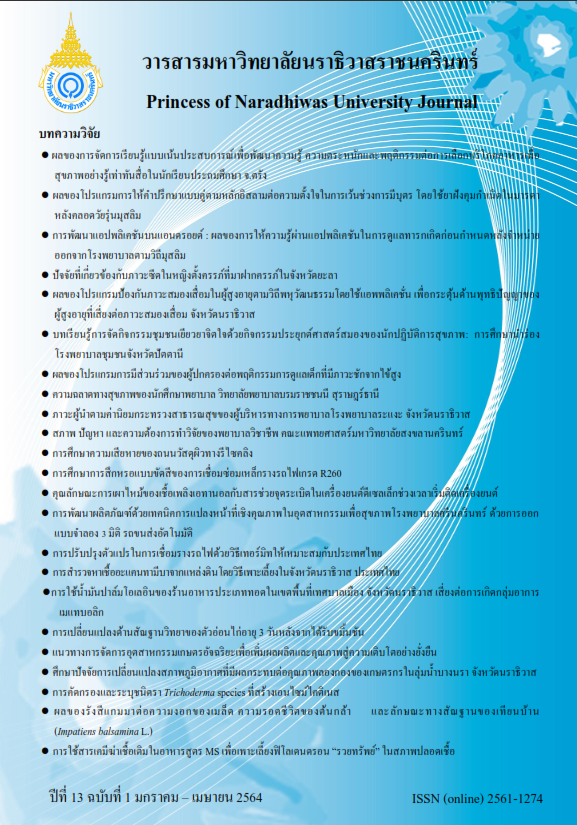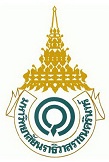การใช้สารเคมีฆ่าเชื้อเติมในอาหารสูตร MS เพื่อเพาะเลี้ยงฟิโลเดนดรอน “รวยทรัพย์” ในสภาพปลอดเชื้อ
คำสำคัญ:
การฆ่าเชื้อด้วยสารเคมี, ไฮเตอร์, เบตาดีน, ฟิโลเดนดรอน, การเพาะเลี้ยงเนื้อเยื่อบทคัดย่อ
งานวิจัยนี้มีวัตถุประสงค์เพื่อศึกษาชนิดและความเข้มข้นของสารเคมีที่เหมาะสมในการทำให้อาหารที่ใช้เพาะเลี้ยงเนื้อเยื่อมีสภาพปลอดเชื้อสำหรับเพาะเลี้ยงปลายยอดฟิโลเดนดรอน “รวยทรัพย์” ด้วยการเติม Haiter® และ Betadine® ความเข้มข้น 2 4 และ 6 มิลลิลิตรต่อลิตร ใช้เวลาศึกษา 60 วัน พบว่าการเติม Haiter® กับBetadine® ทุกระดับความเข้มข้นสามารถยับยั้งการเจริญเติบโตของเชื้อจุลินทรีย์บนอาหารได้ ยอดฟิโลเดนดรอน “รวยทรัพย์” สามารถเจริญเติบโตได้ดี โดยอาหารที่ทำให้ปลอดเชื้อด้วยการเติม Haiter® ที่ระดับความเข้มข้น 2 มิลลิลิตรต่อลิตร ทำให้การเจริญเติบโตทางใบดีที่สุด ทั้งจำนวนและความกว้างใบ สำหรับการเจริญเติบโตทางรากพบว่าอาหารที่เติม Betadine® ทุกระดับความเข้มข้น มีจำนวนและความยาวเฉลี่ยของรากไม่แตกต่างกัน แต่มากกว่าอาหารที่ทำให้ปลอดเชื้อด้วยหม้อนึ่งความดันสูง และอาหารที่ทำให้ปลอดเชื้อด้วยการเติม Haiter® ทุกระดับความเข้มข้น หลังจากนำออกปลูกในโรงเรือนนาน 30 วัน ต้นอ่อนทุกต้นรอดตายและมีการเจริญเติบโตดี การใช้ Haiter® กับ Betadine® ในอาหารเพาะเลี้ยงเนื้อเยื่อระยะเลี้ยงยอดของฟิโลเดนดรอนจึงสามารถทดแทนการนึ่งด้วยหม้อนึ่งความดันสูงซึ่งเป็นวิธีการที่มีต้นทุนสูงได้
References
Ballarin-Denti, A., & Antoniotti, D. (1991). An experimental approach to pH measurement in the intercellular free space of higher plant tissues. Experientia, 47(5), 478 - 482.
Brondani, G., Oliveira, L., Bergonci, T., Brondani, A., França, F., Silva, A., & Gonçalves, A. (2013).Chemical sterilization of culture médium:a low cost alternative to in vitro establishment of plants. Sci. For., 14(98), 257 - 267.
Chansean, M., & Syoichi, I. (2007). Conservation of wild Orchids in Cambodia by Simple Aseptic Culture Method. Proc. NIOC, 13 - 19.
Deein, W., Thepsithar, C., Thongpukdee, A., & Tippornwong, S. (2013). Growth of Chrysanthemum Explants on MS Medium Sterilized by Disinfectants and Essential Oils. International Journal of Bioscience, Biochemistry and Bioinformatics, 3(6), 609 - 613.
Habiba, U., Reza, S., Saha, M.L., Khan, M.R., & Hadiuzzaman, S. (2002). Endogenous bacterial contamination during in vitro culture of table banana: Identification and prevention. Plant Tissue Cult, 12(2), 117 - 124.
Lepelletier, D., Maillard, J. Y., Pozzetto, B., & Simon, A. (2020). Povidone Iodine: Properties, Mechanisms of Action, and Role in Infection Control and Staphylococcus aureus Decolonization. Antimicrob Agents Chemother, 64(9), e00682-20.
Loss-Oliveira, L., Sakuragui, C., Soares, M., & Schrago, C.G. (2016). Evolution of Philodendron (Araceae) species in Neotropical biomes. PeerJ(e1744), 18.
Matsumoto, K., Coelho, M.C., Momte, D.C., & Teixera, J. B. (2009). Sterlization of non-autoclavable vessels and culture media by sodium hypochlorite for in vitro culture. Acta Horti, 839, 329 - 336.
McKeen, L. (2012). Introduction to Food Irradiation and Medical Sterilization. In The Effect of Sterilization on Plastics and Elastomers (Third Edition) (pp. 57 - 84). William Andrew.
Owen, H., Wengerd, D., & Miller, A. (1991). Culture medium pH is influenced by basal medium, carbohydrate source, gelling agent, activated charcoal, and medium storage method. Plant Cell Rep, 10(11), 583 - 586.
Pais, A., Silva, A., Souza, J., Teixeira, S., Ribeiro, J., Peixoto, A., & Paz, C. (2016). Sodium hypochlorite sterilization of culture medium in micropropagation of Gerbera hybrida cv. Essandre. African Journal of Biotechnology, 15(36), 1995 - 1998.
Ramage, C., & Williams, R. (2002). Mineral nutrition and plant morphogenesis. In Vitro Cell Dev Biol Plant, 38(2), 116 - 124.
Russell, A. D. (2003). Similarities and differences in the responses of microorganisms to biocides. Journal of Antimicrobial Chemotherapy, 52, 750 - 763.
Sharma, M., Chaudhary, R., Kureel, R., & Sengar, R. (2018). Effects of culture media pH on In Vitro shoot multiplication in sugarcane. International Journal of Chemical Studies, 6(2), 1308-1310.
Shi, X., Yang, L., Yan, G., & Du, G. (2017). Medium pH between 5.5 and 7.5 has Minimal Effects on Tissue Culture of Apple. HORTSCIENCE, 52(3), 475 - 478.
Technical Service Group of Occidental Chemical Corporation. (2014). Sodium hypochlorite handbook. Dallas: OxyChem.
Teixeira, S. L. (2006). The development of a new protocol that uses sodium hypochlorite to replace the autoclaving procedure for establishing axenic in vitro banana (Musa sp.) culture. Agricell Report, 47(3), 17 - 18.
Weber, B., Witherell, R., & Charkowski, A. (2015). Low-cost potato tissue culture with microwave and bleach media preparation and sterilization. Am. J. Potato Re, 92, 128 - 137.
Yanagawa, T., Nagai, M., Ogino, T., & Maeguch, M. (2006). Application of disinfection to orchid seeds, plantlet and media as a means to prevent in vitro contamination. Lindleyana, 10, 33 - 36.



